Long-Term Characteristics of Surface Soil Moisture over the Tibetan Plateau and Its Response to Climate Change
Abstract
:1. Introduction
2. Study Area
3. Data and Methods
3.1. Data
3.1.1. In Situ Measurements
CAMP/Tibet
ZH2021
3.1.2. Satellite and Reanalysis Datasets
SSM/I
ECV COMBINED
ERA5-Land
MERRA2
GLDAS Noah
| Datasets | Temporal Coverage | Temporal Resolution | Spatial Resolution | Unit | References |
|---|---|---|---|---|---|
| Satellite datasets | |||||
| SSM/I | 07/1987–12/2008 | daily | 0.25°×0.25° | m3 m−3 | van der Velde et al. [26] |
| ECV COMBINED | 11/1978–12/2021 | daily | 0.25°×0.25° | m3 m−3 | Dorigo et al. [32] |
| Reanalysis datasets | |||||
| ERA5-Land | 01/1950–present | hourly; monthly | 0.1°×0.1° | m3 m−3 | Muñoz-Sabater et al. [74] |
| MERRA2 | 01/1980–present | hourly; monthly | 0.625°×0.5° | m3 m−3 | Gelaro et al. [46] |
| GLDAS Noah | 01/1948–01/2015 | 3 hourly; monthly | 0.25°×0.25° | kg m−2 | Rodell et al. [38] |
3.1.3. Meteorological Data and Ancillary Data
3.2. Methods
3.2.1. Data Pre-Processing
3.2.2. Evaluation Metrics
3.2.3. Trend Analysis
3.2.4. Random Forest
3.2.5. Partial Correlation
4. Results
4.1. The Evaluation of Multi-Source Soil Moisture Products
4.2. Long-Term Soil Moisture Characteristics over the TP
4.2.1. The Annual and Seasonal Mean Soil Moisture during 1988–2008
4.2.2. The Annual and Seasonal Trend of Soil Moisture during 1988–2008
4.3. Quantifying the Relative Importance of Each Climatic Variable on TP Soil Moisture
5. Discussions
6. Conclusions
Author Contributions
Funding
Data Availability Statement
Acknowledgments
Conflicts of Interest
References
- Bras, R.L. Hydrology: An Introduction to Hydrologic Science; Addison-Wesley: Boston, MA, USA, 1990. [Google Scholar]
- Peng, J.; Loew, A.; Merlin, O.; Verhoest, N.E.C. A review of spatial downscaling of satellite remotely sensed soil moisture. Rev. Geophys. 2017, 55, 341–366. [Google Scholar] [CrossRef]
- Peng, J.; Albergel, C.; Balenzano, A.; Brocca, L.; Cartus, O.; Cosh, M.H.; Crow, W.T.; Dabrowska-Zielinska, K.; Dadson, S.; Davidson, M.W. A roadmap for high-resolution satellite soil moisture applications–confronting product characteristics with user requirements. Remote Sens. Environ. 2021, 252, 112162. [Google Scholar] [CrossRef]
- Koster, R.D.; Dirmeyer, P.A.; Guo, Z.; Bonan, G.; Chan, E.; Cox, P.; Gordon, C.; Kanae, S.; Kowalczyk, E.; Lawrence, D. Regions of strong coupling between soil moisture and precipitation. Science 2004, 305, 1138–1140. [Google Scholar] [CrossRef] [PubMed]
- Miralles, D.G.; Teuling, A.J.; Van Heerwaarden, C.C.; Vilà-Guerau de Arellano, J. Mega-heatwave temperatures due to combined soil desiccation and atmospheric heat accumulation. Nat. Geosci. 2014, 7, 345–349. [Google Scholar] [CrossRef]
- Dirmeyer, P.A.; Cash, B.A.; Kinter, J.L., III; Stan, C.; Jung, T.; Marx, L.; Towers, P.; Wedi, N.; Adams, J.M.; Altshuler, E.L. Evidence for enhanced land–atmosphere feedback in a warming climate. J. Hydrometeorol. 2012, 13, 981–995. [Google Scholar] [CrossRef]
- Wei, J.; Dirmeyer, P.A. Dissecting soil moisture-precipitation coupling. Geophys. Res. Lett. 2012, 39, L19711. [Google Scholar] [CrossRef]
- Taylor, C.M.; de Jeu, R.A.; Guichard, F.; Harris, P.P.; Dorigo, W.A. Afternoon rain more likely over drier soils. Nature 2012, 489, 423–426. [Google Scholar] [CrossRef]
- Hsu, H.; Dirmeyer, P.A. Soil moisture-evaporation coupling shifts into new gears under increasing CO2. Nat. Commun. 2023, 14, 1162. [Google Scholar] [CrossRef]
- Miralles, D.G.; Gentine, P.; Seneviratne, S.I.; Teuling, A.J. Land–atmospheric feedbacks during droughts and heatwaves: State of the science and current challenges. Ann. NY Acad. Sci. 2019, 1436, 19–35. [Google Scholar] [CrossRef]
- Yao, Y.; Liu, Y.; Zhou, S.; Song, J.; Fu, B. Soil moisture determines the recovery time of ecosystems from drought. Glob. Chang. Biol. 2023, 29, 3562–3574. [Google Scholar] [CrossRef]
- Li, S.; Wang, G.; Zhu, C.; Lu, J.; Ullah, W.; Hagan, D.F.T.; Kattel, G.; Liu, Y.; Zhang, Z.; Song, Y. Vegetation growth due to CO2 fertilization is threatened by increasing vapor pressure deficit. J. Hydrol. 2023, 619, 129292. [Google Scholar] [CrossRef]
- Yao, T.; Bolch, T.; Chen, D.; Gao, J.; Immerzeel, W.; Piao, S.; Su, F.; Thompson, L.; Wada, Y.; Wang, L. The imbalance of the Asian water tower. Nat. Rev. Earth Environ. 2022, 3, 618–632. [Google Scholar] [CrossRef]
- Zhang, Q.; Shen, Z.; Pokhrel, Y.; Farinotti, D.; Singh, V.P.; Xu, C.-Y.; Wu, W.; Wang, G. Oceanic climate changes threaten the sustainability of Asia’s water tower. Nature 2023, 615, 87–93. [Google Scholar] [CrossRef] [PubMed]
- Li, X.; Long, D.; Scanlon, B.R.; Mann, M.E.; Li, X.; Tian, F.; Sun, Z.; Wang, G. Climate change threatens terrestrial water storage over the Tibetan Plateau. Nat. Clim. Chang. 2022, 12, 801–807. [Google Scholar] [CrossRef]
- Seneviratne, S.I.; Corti, T.; Davin, E.L.; Hirschi, M.; Jaeger, E.B.; Lehner, I.; Orlowsky, B.; Teuling, A.J. Investigating soil moisture–climate interactions in a changing climate: A review. Earth-Sci. Rev. 2010, 99, 125–161. [Google Scholar] [CrossRef]
- Ullah, W.; Guojie, W.; Gao, Z.; Tawia Hagan, D.F.; Bhatti, A.S.; Zhua, C. Observed linkage between Tibetan Plateau soil moisture and South Asian summer precipitation and the possible mechanism. J. Clim. 2021, 34, 361–377. [Google Scholar] [CrossRef]
- Zhu, C.; Ullah, W.; Wang, G.; Lu, J.; Li, S.; Feng, A.; Hagan, D.F.T.; Jiang, T.; Su, B. Diagnosing potential impacts of Tibetan Plateau spring soil moisture anomalies on summer precipitation and floods in the Yangtze River basin. J. Geophys. Res. Atmos. 2023, 128, e2022JD037671. [Google Scholar] [CrossRef]
- Wang, A.; Shi, X. A multilayer soil moisture dataset based on the gravimetric method in China and its characteristics. J. Hydrometeorol. 2019, 20, 1721–1736. [Google Scholar] [CrossRef]
- Robinson, D.A.; Jones, S.B.; Wraith, J.M.; Or, D.; Friedman, S.P. A review of advances in dielectric and electrical conductivity measurement in soils using time domain reflectometry. Vadose Zone J. 2003, 2, 444–475. [Google Scholar] [CrossRef]
- Hollinger, S.E.; Isard, S.A. A soil moisture climatology of Illinois. J. Clim. 1994, 7, 822–833. [Google Scholar] [CrossRef]
- Valente, A.; Morais, R.; Tuli, A.; Hopmans, J.; Kluitenberg, G. Multi-functional probe for small-scale simultaneous measurements of soil thermal properties, water content, and electrical conductivity. Sens. Actuators A Phys. 2006, 132, 70–77. [Google Scholar] [CrossRef]
- Ma, Y.; Hu, Z.; Xie, Z.; Ma, W.; Wang, B.; Chen, X.; Li, M.; Zhong, L.; Sun, F.; Gu, L. A long-term (2005–2016) dataset of hourly integrated land–atmosphere interaction observations on the Tibetan Plateau. Earth Syst. Sci. Data 2020, 12, 2937–2957. [Google Scholar] [CrossRef]
- Dorigo, W.; Wagner, W.; Hohensinn, R.; Hahn, S.; Paulik, C.; Xaver, A.; Gruber, A.; Drusch, M.; Mecklenburg, S.; van Oevelen, P. The International Soil Moisture Network: A data hosting facility for global in situ soil moisture measurements. Hydrol. Earth Syst. Sci. 2011, 15, 1675–1698. [Google Scholar] [CrossRef]
- Leng, P.; Li, Z.-L.; Duan, S.-B.; Gao, M.-F.; Huo, H.-Y. A practical approach for deriving all-weather soil moisture content using combined satellite and meteorological data. ISPRS J. Photogramm. Remote Sens. 2017, 131, 40–51. [Google Scholar] [CrossRef]
- Van Der Velde, R.; Salama, M.; Pellarin, T.; Ofwono, M.; Ma, Y.; Su, Z. Long term soil moisture mapping over the Tibetan plateau using Special Sensor Microwave/Imager. Hydrol. Earth Syst. Sci. 2014, 18, 1323–1337. [Google Scholar] [CrossRef]
- Yao, P.; Lu, H.; Shi, J.; Zhao, T.; Yang, K.; Cosh, M.H.; Gianotti, D.J.S.; Entekhabi, D. A long term global daily soil moisture dataset derived from AMSR-E and AMSR2 (2002–2019). Sci. Data 2021, 8, 143. [Google Scholar] [CrossRef] [PubMed]
- Entekhabi, D.; Njoku, E.G.; O’neill, P.E.; Kellogg, K.H.; Crow, W.T.; Edelstein, W.N.; Entin, J.K.; Goodman, S.D.; Jackson, T.J.; Johnson, J. The soil moisture active passive (SMAP) mission. Proc. IEEE 2010, 98, 704–716. [Google Scholar] [CrossRef]
- Kerr, Y.H.; Waldteufel, P.; Wigneron, J.-P.; Delwart, S.; Cabot, F.; Boutin, J.; Escorihuela, M.-J.; Font, J.; Reul, N.; Gruhier, C. The SMOS mission: New tool for monitoring key elements ofthe global water cycle. Proc. IEEE 2010, 98, 666–687. [Google Scholar] [CrossRef]
- Wagner, W.; Hahn, S.; Kidd, R.; Melzer, T.; Bartalis, Z.; Hasenauer, S.; Figa, J.; De Rosnay, P.; Jann, A.; Schneider, S. The ASCAT soil moisture product: A review of its. Meteorol. Z. 2013, 22, 1–29. [Google Scholar] [CrossRef]
- Koike, T.; Nakamura, Y.; Kaihotsu, I.; Davaa, G.; Matsuura, N.; Tamagawa, K.; Fujii, H. Development of an advanced microwave scanning radiometer (AMSR-E) algorithm for soil moisture and vegetation water content. Proc. Hydraul. Eng. 2004, 48, 217–222. [Google Scholar] [CrossRef]
- Dorigo, W.; Wagner, W.; Albergel, C.; Albrecht, F.; Balsamo, G.; Brocca, L.; Chung, D.; Ertl, M.; Forkel, M.; Gruber, A. ESA CCI Soil Moisture for improved Earth system understanding: State-of-the art and future directions. Remote Sens. Environ. 2017, 203, 185–215. [Google Scholar] [CrossRef]
- Denissen, J.M.; Teuling, A.J.; Reichstein, M.; Orth, R. Critical soil moisture derived from satellite observations over Europe. J. Geophys. Res. Atmos. 2020, 125, e2019JD031672. [Google Scholar] [CrossRef]
- Bassiouni, M.; Good, S.P.; Still, C.J.; Higgins, C.W. Plant water uptake thresholds inferred from satellite soil moisture. Geophys. Res. Lett. 2020, 47, e2020GL087077. [Google Scholar] [CrossRef]
- Ford, T.; Harris, E.; Quiring, S. Estimating root zone soil moisture using near-surface observations from SMOS. Hydrol. Earth Syst. Sci. 2014, 18, 139–154. [Google Scholar] [CrossRef]
- Farahmand, A.; Reager, J.; Madani, N. Drought cascade in the terrestrial water cycle: Evidence from remote sensing. Geophys. Res. Lett. 2021, 48, e2021GL093482. [Google Scholar] [CrossRef]
- Muñoz-Sabater, J.; Dutra, E.; Balsamo, G.; Boussetta, S.; Zsoter, E.; Albergel, C.; Agusti-Panareda, A. ERA5-Land: An improved version of the ERA5 reanalysis land component. In Proceedings of the Joint ISWG and LSA-SAF Workshop IPMA, Lisbon, Portugal, 26–28 June 2018; pp. 26–28. [Google Scholar]
- Rodell, M.; Houser, P.; Jambor, U.; Gottschalck, J.; Mitchell, K.; Meng, C.-J.; Arsenault, K.; Cosgrove, B.; Radakovich, J.; Bosilovich, M. The global land data assimilation system. Bull. Am. Meteorol. Soc. 2004, 85, 381–394. [Google Scholar] [CrossRef]
- Reichle, R.H.; Liu, Q.; Koster, R.D.; Draper, C.S.; Mahanama, S.P.; Partyka, G.S. Land surface precipitation in MERRA-2. J. Clim. 2017, 30, 1643–1664. [Google Scholar] [CrossRef]
- Feldman, A.F.; Short Gianotti, D.J.; Dong, J.; Akbar, R.; Crow, W.T.; McColl, K.A.; Konings, A.G.; Nippert, J.B.; Tumber-Dávila, S.J.; Holbrook, N.M. Remotely sensed soil moisture can capture dynamics relevant to plant water uptake. Water Resour. Res. 2023, 59, e2022WR033814. [Google Scholar] [CrossRef]
- Akbar, R.; Short Gianotti, D.; McColl, K.A.; Haghighi, E.; Salvucci, G.D.; Entekhabi, D. Hydrological storage length scales represented by remote sensing estimates of soil moisture and precipitation. Water Resour. Res. 2018, 54, 1476–1492. [Google Scholar] [CrossRef]
- Wang, J.; Qi, L.; He, J.-H.; Wu, Z.-W. Relationship between spring soil moisture in the Tibetan Plateau and summer precipitation in the Yangtze river basin and its possible mechanism. Chin. J. Geophys. 2016, 59, 3985–3995. [Google Scholar]
- Berg, A.; Sheffield, J. Historic and projected changes in coupling between soil moisture and evapotranspiration (ET) in CMIP5 models confounded by the role of different ET components. J. Geophys. Res. Atmos. 2019, 124, 5791–5806. [Google Scholar] [CrossRef]
- Bauer-Marschallinger, B.; Freeman, V.; Cao, S.; Paulik, C.; Schaufler, S.; Stachl, T.; Modanesi, S.; Massari, C.; Ciabatta, L.; Brocca, L. Toward global soil moisture monitoring with Sentinel-1: Harnessing assets and overcoming obstacles. IEEE Trans. Geosci. Remote Sens. 2018, 57, 520–539. [Google Scholar] [CrossRef]
- Fan, L.; Xing, Z.; De Lannoy, G.; Frappart, F.; Peng, J.; Zeng, J.; Li, X.; Yang, K.; Zhao, T.; Shi, J. Evaluation of satellite and reanalysis estimates of surface and root-zone soil moisture in croplands of Jiangsu Province, China. Remote Sens. Environ. 2022, 282, 113283. [Google Scholar] [CrossRef]
- Gelaro, R.; McCarty, W.; Suárez, M.J.; Todling, R.; Molod, A.; Takacs, L.; Randles, C.A.; Darmenov, A.; Bosilovich, M.G.; Reichle, R. The modern-era retrospective analysis for research and applications, version 2 (MERRA-2). J. Clim. 2017, 30, 5419–5454. [Google Scholar] [CrossRef] [PubMed]
- Bi, H.; Ma, J.; Zheng, W.; Zeng, J. Comparison of soil moisture in GLDAS model simulations and in situ observations over the Tibetan Plateau. J. Geophys. Res. Atmos. 2016, 121, 2658–2678. [Google Scholar] [CrossRef]
- Zhao, L.; Zou, D.; Hu, G.; Wu, T.; Du, E.; Liu, G.; Xiao, Y.; Li, R.; Pang, Q.; Qiao, Y. A synthesis dataset of permafrost thermal state for the Qinghai–Tibet (Xizang) Plateau, China. Earth Syst. Sci. Data 2021, 13, 4207–4218. [Google Scholar] [CrossRef]
- Zhang, P.; Zheng, D.; van der Velde, R.; Wen, J.; Zeng, Y.; Wang, X.; Wang, Z.; Chen, J.; Su, Z. Status of the Tibetan Plateau observatory (Tibet-Obs) and a 10-year (2009–2019) surface soil moisture dataset. Earth Syst. Sci. Data 2021, 13, 3075–3102. [Google Scholar] [CrossRef]
- Yang, K.; Qin, J.; Zhao, L.; Chen, Y.; Tang, W.; Han, M.; Lazhu; Chen, Z.; Lv, N.; Ding, B. A multiscale soil moisture and freeze–thaw monitoring network on the third pole. Bull. Am. Meteorol. Soc. 2013, 94, 1907–1916. [Google Scholar]
- Su, Z.; Wen, J.; Dente, L.; Van Der Velde, R.; Wang, L.; Ma, Y.; Yang, K.; Hu, Z. The Tibetan Plateau observatory of plateau scale soil moisture and soil temperature (Tibet-Obs) for quantifying uncertainties in coarse resolution satellite and model products. Hydrol. Earth Syst. Sci. 2011, 15, 2303–2316. [Google Scholar] [CrossRef]
- Liu, J.; Chai, L.; Lu, Z.; Qu, Y.; Wang, J.; Yang, S. Validation of Five Passive Microwave Remotely Sensed Soil Moisture Products over the Qinghai-Tibet Plateau, China. In Proceedings of the IGARSS 2019—2019 IEEE International Geoscience and Remote Sensing Symposium, Yokohama, Japan, 28 July–2 August 2019; pp. 6182–6185. [Google Scholar]
- Wang, G.; Hagan, D.F.T.; Lou, D.; Chen, T. Evaluation of soil moisture derived from FY3B microwave brightness temperature over the Tibetan Plateau. Remote Sens. Lett. 2016, 7, 817–826. [Google Scholar] [CrossRef]
- Dente, L.; Su, Z.; Wen, J. Validation of SMOS soil moisture products over the Maqu and Twente regions. Sensors 2012, 12, 9965–9986. [Google Scholar] [CrossRef]
- Xing, Z.; Fan, L.; Zhao, L.; De Lannoy, G.; Frappart, F.; Peng, J.; Li, X.; Zeng, J.; Al-Yaari, A.; Yang, K. A first assessment of satellite and reanalysis estimates of surface and root-zone soil moisture over the permafrost region of Qinghai-Tibet Plateau. Remote Sens. Environ. 2021, 265, 112666. [Google Scholar] [CrossRef]
- Wang, L.; Liu, H.; Grießinger, J.; Chen, D.; Sun, C.; Fang, C. Enhanced Variability and Declining Trend of Soil Moisture Since the 1880s on the Southeastern Tibetan Plateau. Water Resour. Res. 2023, 59, e2022WR033953. [Google Scholar] [CrossRef]
- Meng, X.; Deng, M.; Talib, J.; Taylor, C.; Wu, P.; Lyu, S.; Chen, H.; Li, Z.; Zhao, L. Diagnosing product variability in the soil moisture response to precipitation on the Tibetan Plateau. J. Hydrometeorol. 2023, 24, 625–639. [Google Scholar] [CrossRef]
- Chen, W.; Yao, T.; Zhang, G.; Woolway, R.I.; Yang, W.; Xu, F.; Zhou, T. Glacier surface heatwaves over the Tibetan Plateau. Geophys. Res. Lett. 2023, 50, e2022GL101115. [Google Scholar] [CrossRef]
- Wu, P.; Liu, Y.-J.; Wang, J.; Ding, Y.-H. Revisiting the variations of precipitation and water vapour budget over the Tibetan Plateau. Adv. Clim. Chang. Res. 2023, 14, 77–84. [Google Scholar] [CrossRef]
- Wang, L.; Lu, J.; Zhou, R.; Duan, G.; Wen, Z. Analysis of Soil Moisture Change Characteristics and Influencing Factors of Grassland on the Tibetan Plateau. Remote Sens. 2023, 15, 298. [Google Scholar] [CrossRef]
- Wang, H.; Zan, B.; Wei, J.; Song, Y.; Mao, Q. Spatiotemporal characteristics of soil Moisture and land–atmosphere coupling over the Tibetan Plateau derived from three gridded datasets. Remote Sens. 2022, 14, 5819. [Google Scholar] [CrossRef]
- Tawia Hagan, D.F.; Wang, G.; San Liang, X.; Dolman, H.A. A time-varying causality formalism based on the Liang–Kleeman information flow for analyzing directed interactions in nonstationary climate systems. J. Clim. 2019, 32, 7521–7537. [Google Scholar] [CrossRef]
- Li, W.; Migliavacca, M.; Forkel, M.; Denissen, J.M.; Reichstein, M.; Yang, H.; Duveiller, G.; Weber, U.; Orth, R. Widespread increasing vegetation sensitivity to soil moisture. Nat. Commun. 2022, 13, 3959. [Google Scholar] [CrossRef]
- Sun, H.; Liu, X. Impacts of dynamic and thermal forcing by the Tibetan Plateau on the precipitation distribution in the Asian arid and monsoon regions. Clim. Dyn. 2021, 56, 2339–2358. [Google Scholar] [CrossRef]
- Qu, Y.; Zhu, Z.; Chai, L.; Liu, S.; Montzka, C.; Liu, J.; Yang, X.; Lu, Z.; Jin, R.; Li, X. Rebuilding a microwave soil moisture product using random forest adopting AMSR-E/AMSR2 brightness temperature and SMAP over the Qinghai–Tibet Plateau, China. Remote Sens. 2019, 11, 683. [Google Scholar] [CrossRef]
- Cui, A.; Lu, H.; Liu, X.; Shen, C.; Xu, D.; Xu, B.; Wu, N. Tibetan plateau precipitation modulated by the periodically coupled westerlies and Asian monsoon. Geophys. Res. Lett. 2021, 48, e2020GL091543. [Google Scholar] [CrossRef]
- Yang, S.; Zeng, J.; Fan, W.; Cui, Y. Evaluating Root-Zone Soil Moisture Products from GLEAM, GLDAS, and ERA5 Based on In Situ Observations and Triple Collocation Method over the Tibetan Plateau. J. Hydrometeorol. 2022, 23, 1861–1878. [Google Scholar] [CrossRef]
- Ran, Y.; Li, X.; Lu, L.; Li, Z. Large-scale land cover mapping with the integration of multi-source information based on the Dempster–Shafer theory. Int. J. Geogr. Inf. Sci. 2012, 26, 169–191. [Google Scholar] [CrossRef]
- Ma, Y.; Su, Z.; Koike, T.; Yao, T.; Ishikawa, H.; Ueno, K.i.; Menenti, M. On measuring and remote sensing surface energy partitioning over the Tibetan Plateau––from GAME/Tibet to CAMP/Tibet. Phys. Chem. Earth Parts A/B/C 2003, 28, 63–74. [Google Scholar] [CrossRef]
- Jiang, H.; Yi, Y.; Zhang, W.; Yang, K.; Chen, D. Sensitivity of soil freeze/thaw dynamics to environmental conditions at different spatial scales in the central Tibetan Plateau. Sci. Total Environ. 2020, 734, 139261. [Google Scholar] [CrossRef] [PubMed]
- Ge, N.; Zhong, L.; Ma, Y.; Cheng, M.; Wang, X.; Zou, M.; Huang, Z. Estimation of land surface heat fluxes based on Landsat 7 ETM+ data and field measurements over the northern Tibetan Plateau. Remote Sens. 2019, 11, 2899. [Google Scholar] [CrossRef]
- Wang, G.; Garcia, D.; Liu, Y.; De Jeu, R.; Dolman, A.J. A three-dimensional gap filling method for large geophysical datasets: Application to global satellite soil moisture observations. Environ. Model. Softw. 2012, 30, 139–142. [Google Scholar] [CrossRef]
- Gruber, A.; Scanlon, T.; van der Schalie, R.; Wagner, W.; Dorigo, W. Evolution of the ESA CCI Soil Moisture climate data records and their underlying merging methodology. Earth Syst. Sci. Data 2019, 11, 717–739. [Google Scholar] [CrossRef]
- Muñoz-Sabater, J.; Dutra, E.; Agustí-Panareda, A.; Albergel, C.; Arduini, G.; Balsamo, G.; Boussetta, S.; Choulga, M.; Harrigan, S.; Hersbach, H. ERA5-Land: A state-of-the-art global reanalysis dataset for land applications. Earth Syst. Sci. Data 2021, 13, 4349–4383. [Google Scholar] [CrossRef]
- Hagan, D.F.T.; Parinussa, R.M.; Wang, G.; Draper, C.S. An evaluation of soil moisture anomalies from global model-based datasets over the people’s republic of China. Water 2019, 12, 117. [Google Scholar] [CrossRef]
- Zhu, Z.; Shi, C. Simulation and evaluation of CLDAS and GLDAS soil moisture data in China. Sci. Technol. Eng. 2014, 14, 138–144. [Google Scholar]
- Deng, M.; Meng, X.; Li, Z.; Lyv, Y.; Lei, H.; Zhao, L.; Zhao, S.; Ge, J.; Jing, H. Responses of soil moisture to regional climate change over the three rivers source region on the tibetan plateau. Int. J. Climatol. 2020, 40, 2403–2417. [Google Scholar] [CrossRef]
- Mingshan, D.; Xianhong, M.; Yingsai, M.; Yingying, A. Analysis on soil moisture characteristics of Tibetan Plateau based on GLDAS. J. Arid Meteorol. 2018, 36, 595. [Google Scholar]
- He, J.; Yang, K.; Tang, W.; Lu, H.; Qin, J.; Chen, Y.; Li, X. The first high-resolution meteorological forcing dataset for land process studies over China. Sci. Data 2020, 7, 25. [Google Scholar] [CrossRef] [PubMed]
- Wilcox, R.R. Fundamentals of Modern Statistical Methods: Substantially Improving Power and Accuracy; Springer: Berlin/Heidelberg, Germany, 2010; Volume 249. [Google Scholar]
- Lu, J.; Wang, G.; Li, S.; Feng, A.; Zhan, M.; Jiang, T.; Su, B.; Wang, Y. Projected land evaporation and its response to vegetation greening over China under multiple scenarios in the CMIP6 models. J. Geophys. Res. Biogeosci. 2021, 126, e2021JG006327. [Google Scholar] [CrossRef]
- Mann, H.B. Nonparametric tests against trend. Econom. J. Econom. Soc. 1945, 13, 245–259. [Google Scholar] [CrossRef]
- Kendall, M.G. Rank Correlation Methods; Griffin: London, UK, 1975. [Google Scholar]
- Rial, M.; Cortizas, A.M.; Rodríguez-Lado, L. Understanding the spatial distribution of factors controlling topsoil organic carbon content in European soils. Sci. Total Environ. 2017, 609, 1411–1422. [Google Scholar] [CrossRef]
- Chen, Y.; Yang, K.; Qin, J.; Zhao, L.; Tang, W.; Han, M. Evaluation of AMSR-E retrievals and GLDAS simulations against observations of a soil moisture network on the central Tibetan Plateau. J. Geophys. Res. Atmos. 2013, 118, 4466–4475. [Google Scholar] [CrossRef]
- Dai, L.; Fu, R.; Guo, X.; Du, Y.; Zhang, F.; Cao, G. Soil moisture variations in response to precipitation across different vegetation types on the northeastern Qinghai-Tibet plateau. Front. Plant Sci. 2022, 13, 854152. [Google Scholar] [CrossRef]
- Nayak, H.P.; Nayak, S.; Maity, S.; Patra, N.; Singh, K.S.; Dutta, S. Sensitivity of Land Surface Processes and Its Variation during Contrasting Seasons over India. Atmosphere 2022, 13, 1382. [Google Scholar] [CrossRef]
- Zhang, T.; Shen, S.; Cheng, C. Impact of radiations on the long-range correlation of soil moisture: A case study of the A’rou superstation in the Heihe River Basin. J. Geogr. Sci. 2019, 29, 1491–1506. [Google Scholar] [CrossRef]
- Yang, K.; He, J.; Tang, W.; Qin, J.; Cheng, C.C. On downward shortwave and longwave radiations over high altitude regions: Observation and modeling in the Tibetan Plateau. Agric. For. Meteorol. 2010, 150, 38–46. [Google Scholar] [CrossRef]
- Bartold, M.; Kluczek, M. A Machine Learning Approach for Mapping Chlorophyll Fluorescence at Inland Wetlands. Remote Sens. 2023, 15, 2392. [Google Scholar] [CrossRef]
- Karthikeyan, L.; Mishra, A.K. Multi-layer high-resolution soil moisture estimation using machine learning over the United States. Remote Sens. Environ. 2021, 266, 112706. [Google Scholar] [CrossRef]

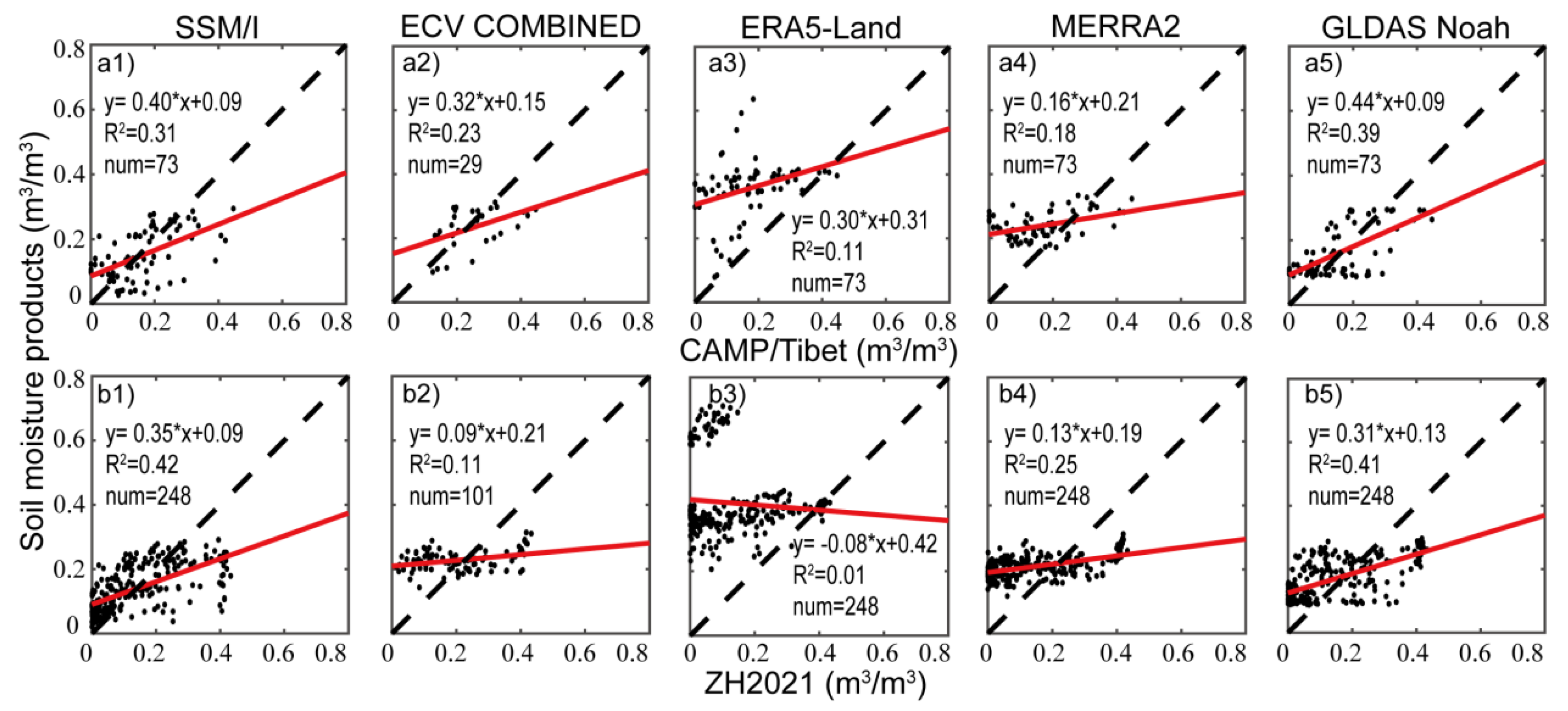
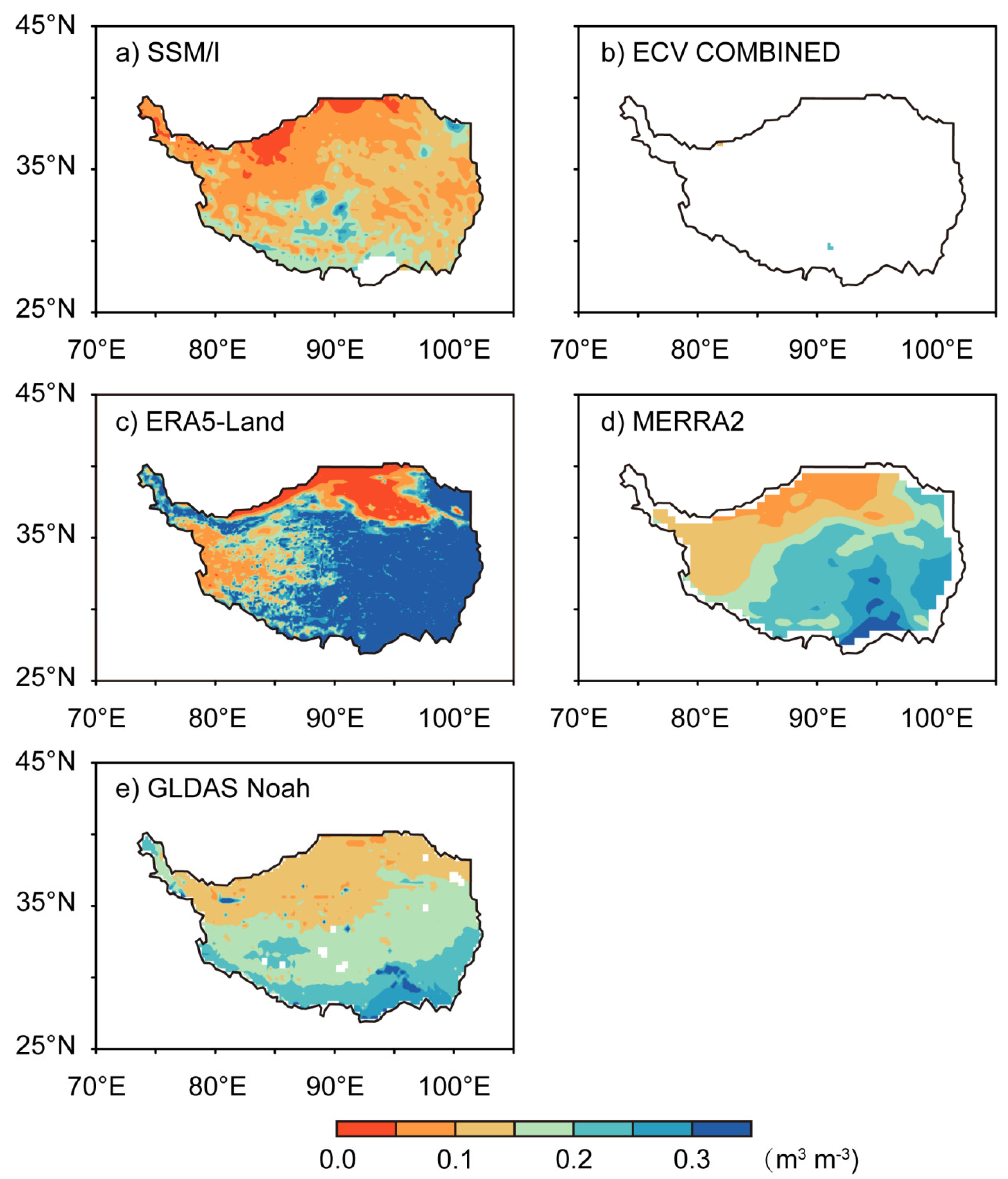
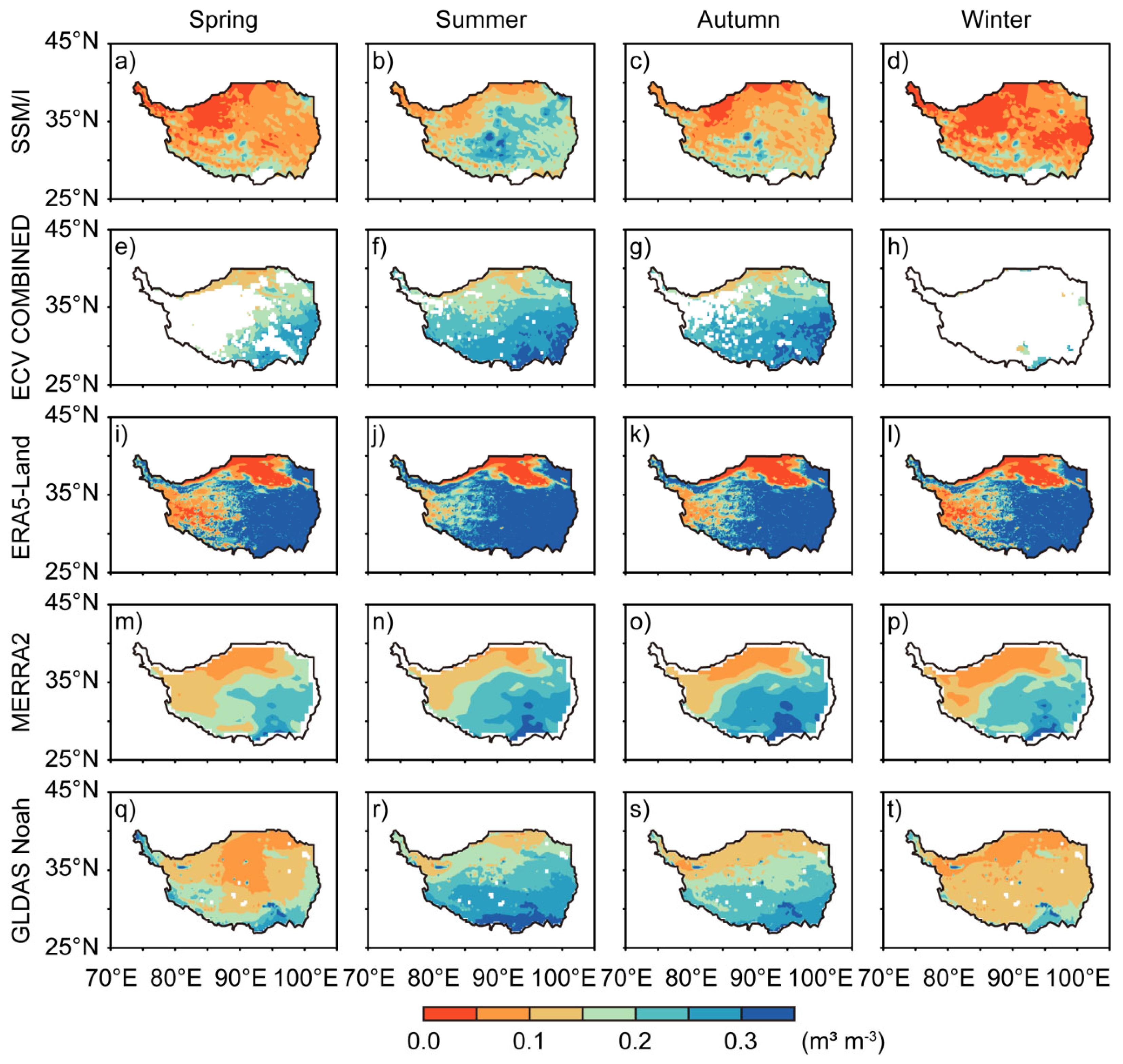
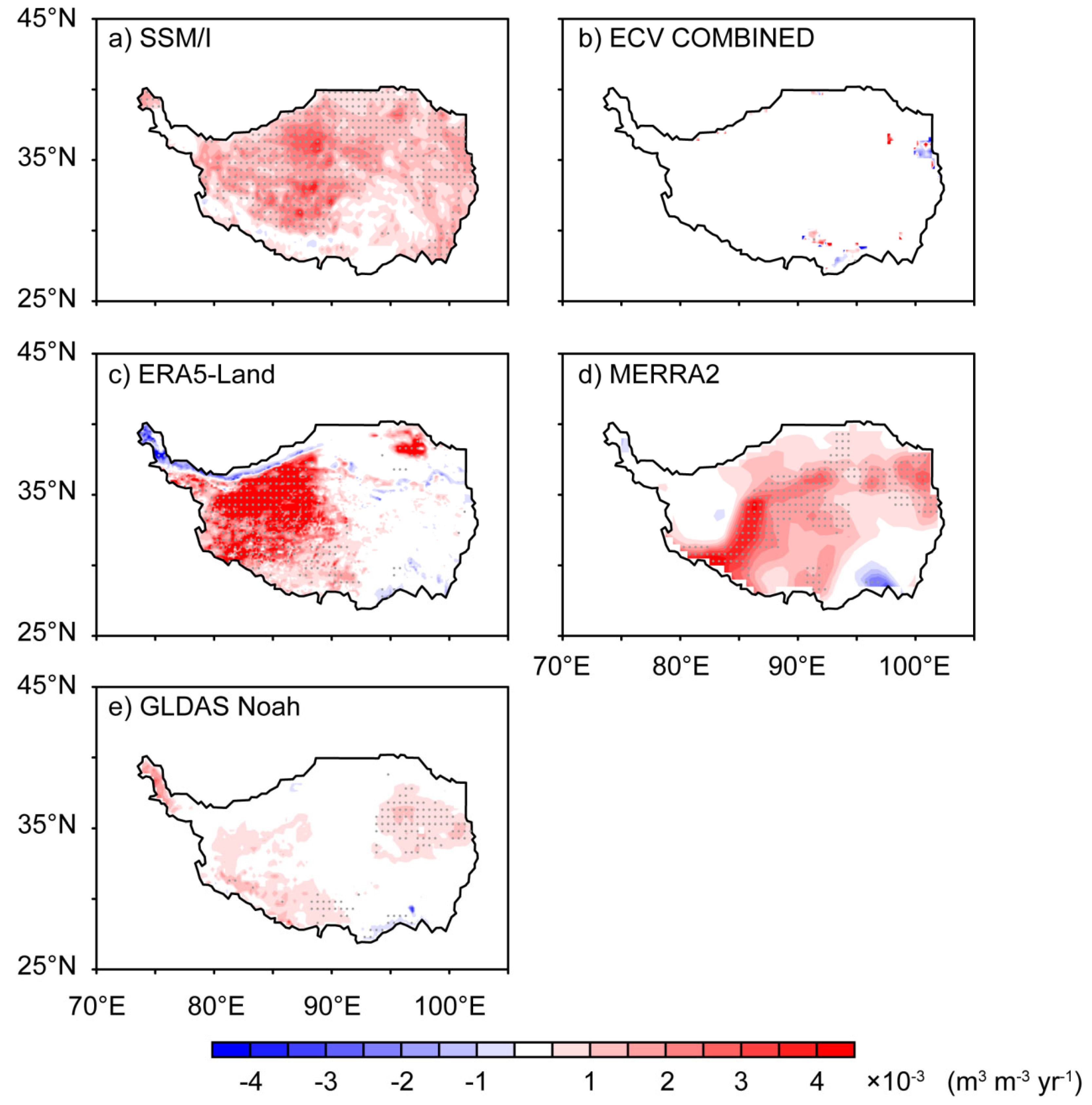
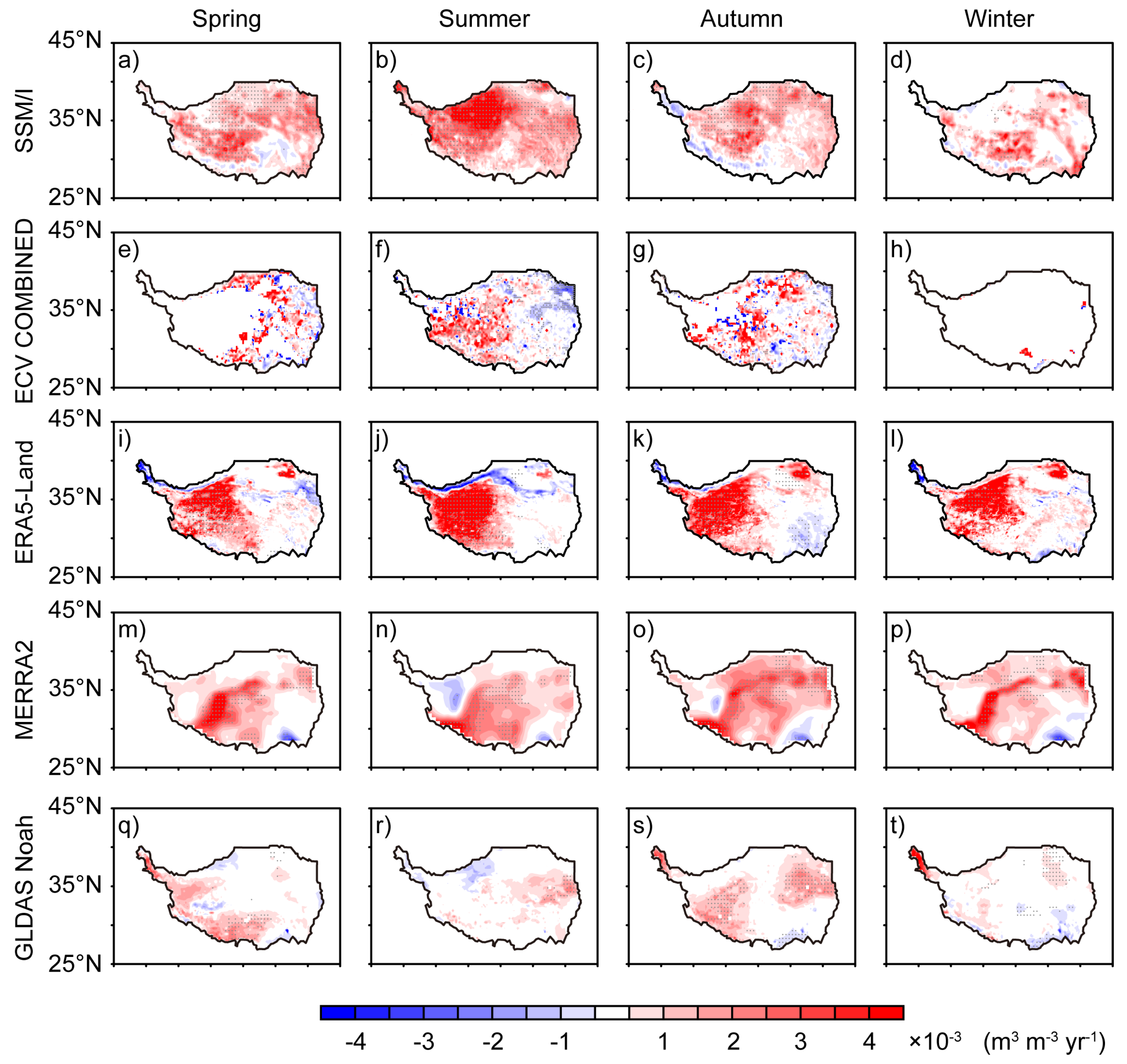
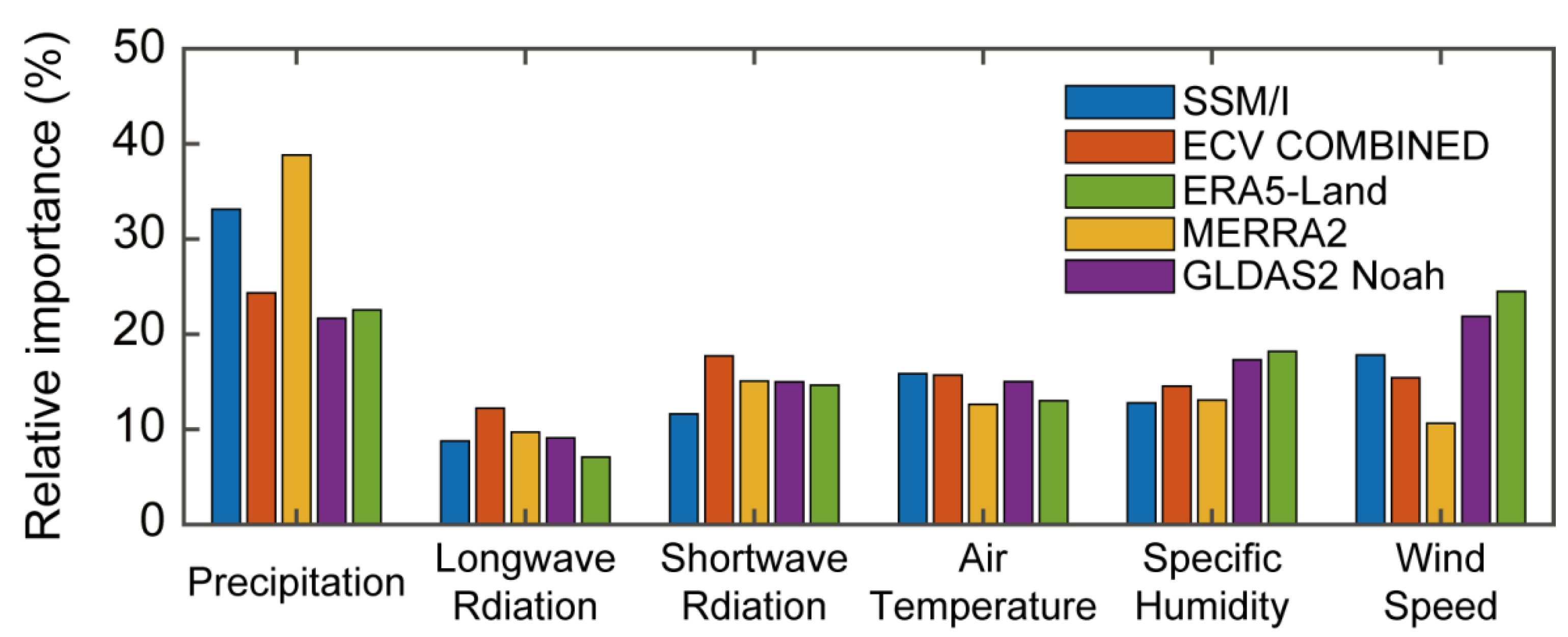
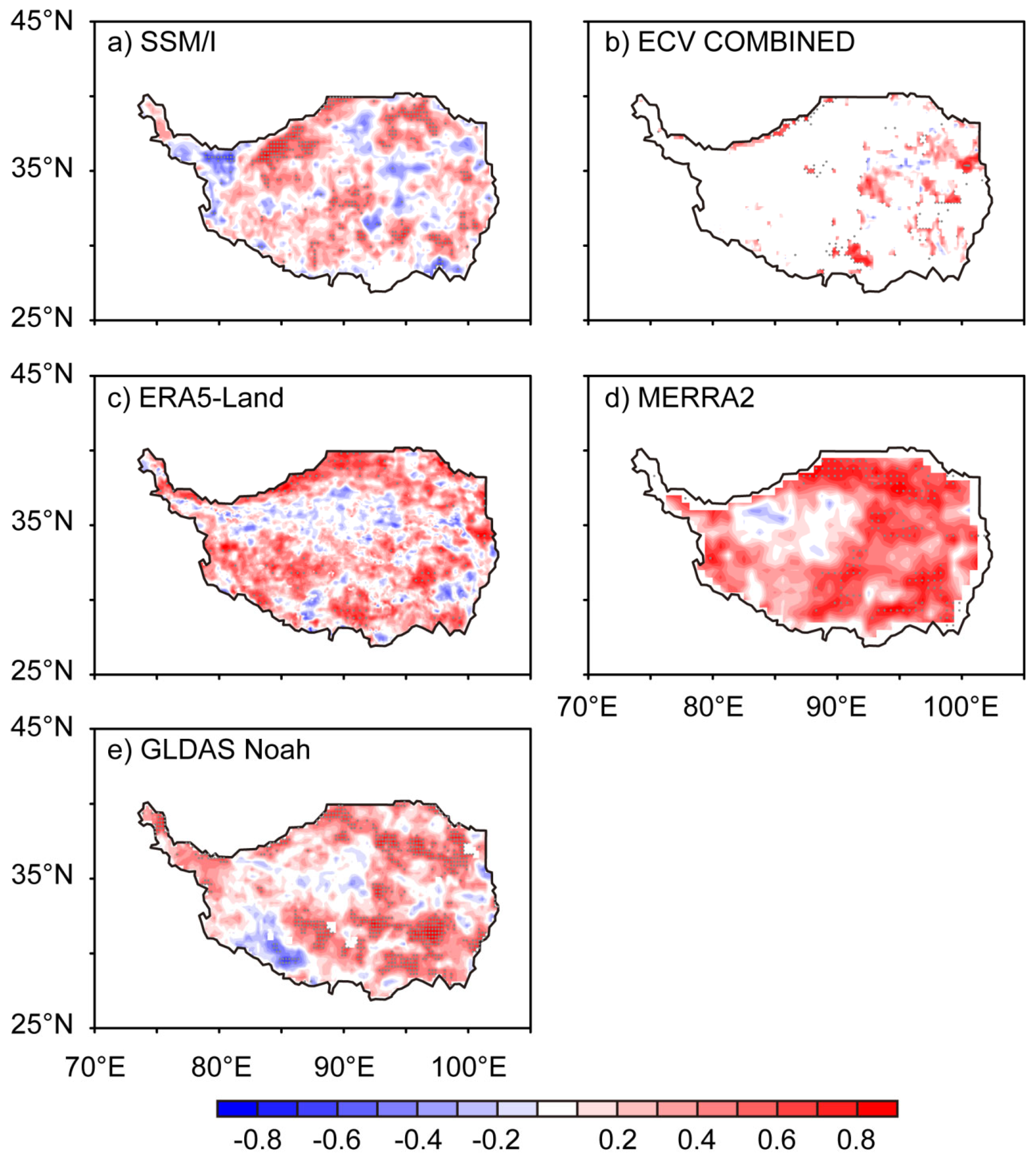
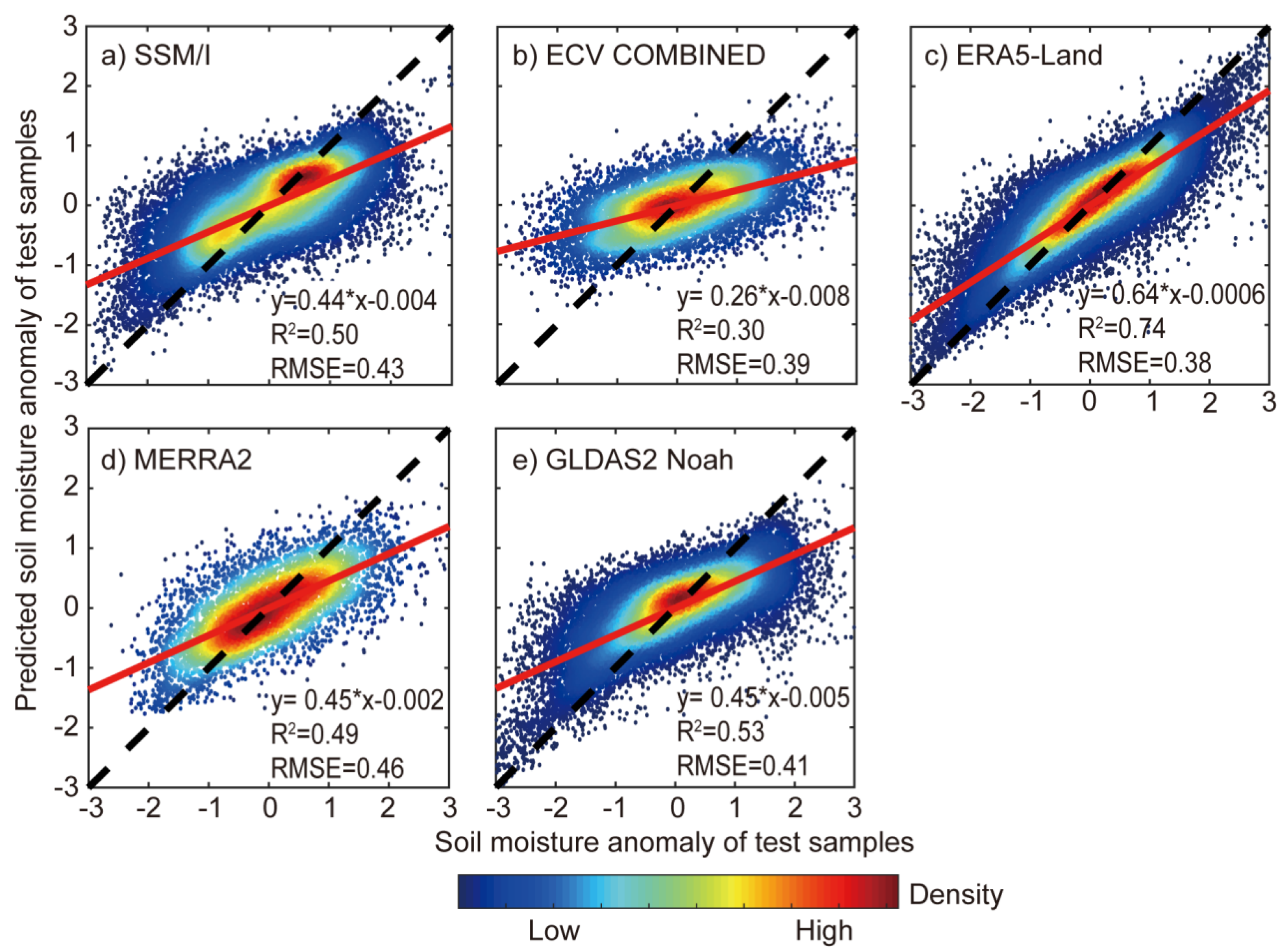
| Sites Name | Longitude (°E) | Latitude (°N) | Time Range | Depth (m) | |
|---|---|---|---|---|---|
| CAMP/Tibet | Amdo | 91.62 | 32.24 | 01/10/2002–04/09/2003 | −2.79, −2.58, −2.00, −1.60, −1.30, −1.00, −0.80, −0.60, −0.40, −0.20, −0.04 |
| BJ | 91.90 | 31.37 | 01/10/2002–31/03/2004 | −2.50, −2.10, −2.00, −1.60, −1.30, −1.00, −0.80, −0.60, −0.40, −0.20, −0.04 | |
| D66 | 93.78 | 35.52 | 01/10/2002–31/03/2004 | −2.50, −2.25, −2.00, −1.60, −1.30, −1.00, −0.80, −0.60, −0.40, −0.20, −0.04 | |
| D105 | 91.94 | 33.06 | 01/10/2002–31/03/2004 | −1.90, −1.85, −1.80, −1.60, −1.30, −1.00, −0.80, −0.60, −0.40, −0.20, −0.04 | |
| D110 | 91.87 | 32.69 | 01/10/2002–31/03/2004 | −1.80, −1.60, −1.30, −1.00, −0.80, −0.60, −0.40, −0.20,−0.04, 0.00 | |
| MS3608 | 91.78 | 31.23 | 01/10/2002–31/03/2004 | −2.42, −2.00, −1.96, −1.60, −1.30, −1.00, −0.80, −0.60, −0.40, −0.20, −0.04 | |
| Tuotuohe | 92.44 | 34.22 | 01/10/2002–31/03/2004 | −2.71, −2.30, −2.00, −1.60, −1.30, −1.00, −0.80, −0.60, −0.40, −0.20, −0.04 | |
| ZH2021 | Ch04 | 91.74 | 31.82 | 07/06/2001–31/12/2006 | −1.20, −0.95, −0.50, −0.15 |
| Ch06 | 94.06 | 35.62 | 01/01/2005–31/12/2016 | −1.80, −1.00, −0.40, −0.10 | |
| QT01 | 93.04 | 35.14 | 01/01/2004–01/10/2014 | −1.80, −1.00, −0.50, −0.10 | |
| QT03 | 92.92 | 34.82 | 01/01/2004–31/12/2014 | −2.40, −1.80, −0.90, −0.50, −0.05 | |
| QT05 | 92.34 | 33.96 | 01/01/2004–31/12/2008 | −2.70, −2.10, −0.90, −0.60, −0.10 |
| R | BIAS | MAE | RMSE | ubRMSE | |
|---|---|---|---|---|---|
| CAMP/Tibet | |||||
| SSM/I | 0.56 | −0.01 | 0.07 | 0.09 | 0.09 |
| ECV COMBINED | 0.48 | −0.02 | 0.07 | 0.08 | 0.08 |
| ERA5-Land | 0.33 | 0.19 | 0.19 | 0.23 | 0.12 |
| MERRA2 | 0.42 | 0.08 | 0.10 | 0.12 | 0.10 |
| GLDAS Noah | 0.63 | 0.00 | 0.07 | 0.08 | 0.08 |
| ZH2021 | |||||
| SSM/I | 0.65 | 0.00 | 0.08 | 0.10 | 0.10 |
| ECV COMBINED | 0.34 | 0.02 | 0.10 | 0.12 | 0.11 |
| ERA5-Land | −0.09 | 0.28 | 0.28 | 0.33 | 0.18 |
| MERRA2 | 0.50 | 0.07 | 0.13 | 0.14 | 0.12 |
| GLDAS Noah | 0.64 | 0.03 | 0.09 | 0.11 | 0.10 |
Disclaimer/Publisher’s Note: The statements, opinions and data contained in all publications are solely those of the individual author(s) and contributor(s) and not of MDPI and/or the editor(s). MDPI and/or the editor(s) disclaim responsibility for any injury to people or property resulting from any ideas, methods, instructions or products referred to in the content. |
© 2023 by the authors. Licensee MDPI, Basel, Switzerland. This article is an open access article distributed under the terms and conditions of the Creative Commons Attribution (CC BY) license (https://creativecommons.org/licenses/by/4.0/).
Share and Cite
Zhu, C.; Li, S.; Hagan, D.F.T.; Wei, X.; Feng, D.; Lu, J.; Ullah, W.; Wang, G. Long-Term Characteristics of Surface Soil Moisture over the Tibetan Plateau and Its Response to Climate Change. Remote Sens. 2023, 15, 4414. https://doi.org/10.3390/rs15184414
Zhu C, Li S, Hagan DFT, Wei X, Feng D, Lu J, Ullah W, Wang G. Long-Term Characteristics of Surface Soil Moisture over the Tibetan Plateau and Its Response to Climate Change. Remote Sensing. 2023; 15(18):4414. https://doi.org/10.3390/rs15184414
Chicago/Turabian StyleZhu, Chenxia, Shijie Li, Daniel Fiifi Tawia Hagan, Xikun Wei, Donghan Feng, Jiao Lu, Waheed Ullah, and Guojie Wang. 2023. "Long-Term Characteristics of Surface Soil Moisture over the Tibetan Plateau and Its Response to Climate Change" Remote Sensing 15, no. 18: 4414. https://doi.org/10.3390/rs15184414







